Characteristics of Air Toxics from Multiple Sources in the Kaohsiung Coastal Industrial Complex and Port Area
Abstract
1. Introduction
2. Materials and Methods
2.1. Method for Estimating HAP Emissions
2.1.1. Estimation of HAP Emissions from Stationary Sources
- Estimation of heavy metal emissions
- Estimation of VOC emissions
2.1.2. Estimation of HAP Emissions from Mobile Sources
- Mobile-source activity intensity
- Estimation of the total mileage from motor vehicles
- Average annual fuel consumption of each vehicle type
- Average annual fuel consumption ratio of gasoline/diesel vehicles
- Total vehicle mileage traveled on different roads in different years
- Average annual mileage of each vehicle age
- Estimation of the activity intensity for each vehicle type during different periods
- Mobile-source emission factor
- Construction of road-grid activity intensity
2.1.3. Estimation of HAP Emissions from Port Activities
2.2. Carcinogenic Weight of Emission Characteristics
2.3. Model Performance Evaluation and Correction
2.4. Simulation Analysis of HAP Concentration
2.5. Environmental Impact Assessment
3. Results and Discussion
3.1. Emission Characteristics of Composite Emission Sources
3.1.1. Stationary-Source Emission Characteristics
3.1.2. Mobile Sources
3.1.3. Port Activities
3.1.4. Composite Sources
3.2. Emission Calibration
3.2.1. Performance Verification Evaluation
- 1.
- Benzene
- 2.
- Formaldehyde
- 3.
- Arsenic
- 4.
- DPM
3.2.2. Emission Corrections
- 1.
- Formaldehyde
- 2.
- Arsenic
- 3.
- DPM
3.3. Analysis of Simulated HAPs
- 1.
- Benzene
- 2.
- Formaldehyde
- 3.
- 1,3-Butadiene
- 4.
- Vinyl chloride
- 5.
- Arsenic
- 6.
- DPM
3.4. Potential Risk Assessment of Hotspots
- 1.
- Benzene
- 2.
- Formaldehyde
- 3.
- 1,3-Butadiene
- 4.
- Arsenic
- 5.
- DPM
- 6.
- Total cancer risk
4. Conclusions
Author Contributions
Funding
Institutional Review Board Statement
Informed Consent Statement
Data Availability Statement
Acknowledgments
Conflicts of Interest
References
- Malakan, W.; Thepanondh, S.; Keawboonchu, J.; Kultan, V.; Kondo, A.; Shimadera, H. Integrated assessment of inhalation health risk and economic benefit of improving ambient targeted VOCs in Petrochemical industrial area. Air Qual. Atmos. Health 2024, 17, 1885–1903. [Google Scholar] [CrossRef]
- Tsagatakis, I.; Richardson, J.; Evangelides, C.; Pizzolato, M.; Richmond, B.; Hows, S.-M.; Pearson, B.; Passant, N.; Pommier, M.; Otto, A. UK Spatial Emissions Methodology: A Report of the National Atmospheric Emission Inventory 2021. 2023. Available online: https://naei.beis.gov.uk/reports/reports?report_id=1112 (accessed on 20 May 2023).
- Stroud, C.A.; Zaganescu, C.; Chen, J.; McLinden, C.A.; Zhang, J.; Wang, D. Toxic volatile organic air pollutants across Canada: Multi-year concentration trends, regional air quality modelling and source apportionment. J. Atmos. Chem. 2016, 73, 137–164. [Google Scholar] [CrossRef]
- Munshed, M.; Van Griensven Thé, J.; Fraser, R. Methodology for mobile toxics deterministic human health risk assessment and case study. Atmosphere 2023, 14, 506. [Google Scholar] [CrossRef]
- Truong, S.C.H.; Lee, M.I.; Kim, G.; Kim, D.; Park, J.H.; Choi, S.D.; Cho, G.H. Accidental benzene release risk assessment in an urban area using an atmospheric dispersion model. Atmos. Environ. 2016, 144, 146–159. [Google Scholar] [CrossRef]
- Afzali, A.; Rashid, M.; Noorhafizah, K.; Ammar, M.R. Evaluating human exposure to emission from incineration pant using AERMOD dispersion modeling. Iran. J. Public Health 2014, 43, 25–33. [Google Scholar]
- Mo, Z.; Lu, S.; Shao, M. Volatile organic compound (VOC) emissions and health risk assessment in paint and coatings industry in the Yangtze River Delta, China. Environ. Pollut. 2021, 269, 115740. [Google Scholar] [CrossRef] [PubMed]
- Propper, R.; Wong, P.; Bui, S.; Austin, J.; Vance, W.; Alvarado, Á.; Croes, B.; Luo, D. Ambient and emission trends of toxic air contaminants in California. Environ. Sci. Technol. 2015, 49, 11329–11339. [Google Scholar] [CrossRef] [PubMed]
- Jia, C.; Faran, J. Air toxics concentrations, source identification, and health risks: An air pollution hot spot in southwest Memphis, TN. Atmos. Environ. 2013, 81, 112–116. [Google Scholar] [CrossRef]
- Ekenga, C.C.; Yeung, C.Y.; Oka, M. Cancer risk from air toxics in relation to neighborhood isolation and sociodemographic characteristics: A spatial analysis of the St. Louis metropolitan area, USA. Environ. Res. 2019, 179, 108844. [Google Scholar] [CrossRef] [PubMed]
- Xiong, Y.; Bari, M.A.; Xing, Z.; Du, K. Ambient volatile organic compounds (VOCs) in two coastal cities in western Canada: Spatiotemporal variation, source apportionment, and health risk assessment. Sci. Total Environ. 2020, 706, 135970. [Google Scholar] [CrossRef] [PubMed]
- South Coast Air Quality Management District (SCAQMD). Multiple Air Toxics Exposure Study (MATES-V); South Coast Air Quality Management District (SCAQMD): Diamond Bar, CA, USA, 2021.
- The Office of Environmental Health Hazard Assessment (OEHHA). Air Toxics Hot Spots Program Guidance Manual; The Office of Environmental Health Hazard Assessment (OEHHA): Sacramento, CA, USA, 2015.
- The Ministry of Environment (MOENV). Stationary Pollution Source Management Information Dis-Closure Platform. 2024. Available online: https://aodmis.moenv.gov.tw/opendata/#/ab/1 (accessed on 20 May 2023).
- United States Environmental Protection Agency (USEPA). SPECIATE Version 5.2 Database Development Documentation Addendum. 2022. Available online: https://www.epa.gov/air-emissions-modeling/speciate-2 (accessed on 23 April 2023).
- The Ministry of Environment (MOENV). Plan of Audit Hazardous Air Pollutants Emission from Stationary Sources; The Ministry of Environment (MOENV): Taipei, Taiwan, 2020; EPA-109-FAfrom3-A106.
- The Ministry of Environment (MOENV). Taiwan Emission Data System Version 12.0 (TEDS 12.0)-Line Source Estimation Manual; The Ministry of Environment (MOENV): Taipei, Taiwan, 2023.
- Energy Bureau of the Ministry of Economic Affairs. Annual Energy Report (Energy Balance); Energy Bureau of the Ministry of Economic Affairs: Taipei, Taiwan, 2023.
- Energy Bureau of the Ministry of Economic Affairs. Monthly Statistics Data on Gasoline and Diesel Sales at Gas Stations in Various Counties and Cities. 2024. Available online: https://www.moeaea.gov.tw/ECW/populace/content/wfrmStatistics.aspx?type=2&menu_id=1300&sub_menu_id=5691 (accessed on 20 April 2024).
- Ministry of Transportation and Communications (MOTC). Highway Statistical Data Query. 2024. Available online: https://stat.thb.gov.tw/hb01/webMain.aspx?sys=100&funid=11100 (accessed on 18 March 2024).
- Liu, H.C. Mobile Sources Air Toxic Characterization and Effectiveness of Control Strategy in Metropolitan Area. Master’s Thesis, National Cheng-Kung University, Tainan City, Taiwan, 2018. [Google Scholar]
- Transportation Research Institute of the Ministry of Transport. The Research on the Access Transportation Improvement for Intercontinental Container Center in Kaohsiung Port; Transportation Research Institute of the Ministry of Transport: Taipei, Taiwan, 2021. [Google Scholar]
- The Ministry of Environment (MOENV). Program on Promoting Emission Mitigation at Harbor and Airport Area and Auditing Fuel of Mobile Source; The Ministry of Environment (MOENV): Taipei, Taiwan, 2023.
- Starcrest Consulting Group. San Pedro Bay Ports Emissions Inventory Methodology Report; Starcrest Consulting Group: Park City, UT, USA, 2022. [Google Scholar]
- USEPA. User’s Guide for the AMS/EPA Regulatory Model (AERMOD); USEPA: Washington, DC, USA, 2024; EPA-454/B-24-007.
- Kotrikla, A.; Dimou, K.; Korras-Carraca, M.; Biskos, G. Air quality modelling in the city of Mytilene, Greece. In Proceedings of the 13th International Conference on Environmental Science and Technology, Athens, Greece, 5–7 September 2013; pp. 5–7. [Google Scholar]
- World Health Organization (WHO). Air Quality Guidelines; World Health Organization (WHO): Copenhagen, Denmark, 2006. Available online: https://iris.who.int/bitstream/handle/10665/107823/9789289021920-eng.pdf?sequence=1 (accessed on 20 March 2023).
- Texas Commission on Environmental Quality. Air Monitoring Comparison Values. Available online: https://www.tceq.texas.gov/toxicology/amcv (accessed on 20 March 2023).
- Ministry of Environment, Japan. Environmental Standards and Guideline Values. Available online: https://www.env.go.jp/content/900403381.pdf (accessed on 20 March 2023).
- Li, L.; Zhang, D.; Hu, W.; Yang, Y.; Zhang, S.; Yuan, R.; Lv, P.; Zhang, W.; Zhang, Y.; Zhang, Y. Improving VOC control strategies in industrial parks based on emission behavior, environmental effects, and health risks: A case study through atmospheric measurement and emission inventory. Sci. Total Environ. 2023, 865, 161235. [Google Scholar] [CrossRef] [PubMed]
- Liu, C.; Xin, Y.; Zhang, C.; Liu, J.; Liu, P.; He, X.; Mu, Y. Ambient volatile organic compounds in urban and industrial regions in Beijing: Characteristics, source apportionment, secondary transformation and health risk assessment. Sci. Total Environ. 2023, 855, 158873. [Google Scholar] [CrossRef] [PubMed]
- Yang, Y.; Ji, D.; Sun, J.; Wang, Y.; Yao, D.; Zhao, S.; Yu, X.; Zeng, L.; Zhang, R.; Zhang, H.; et al. Ambient volatile organic compounds in a suburban site between Beijing and Tianjin: Concentration levels, source apportionment and health risk assessment. Sci. Total Environ. 2019, 695, 133889. [Google Scholar] [CrossRef]
- Tsai, J.H.; Hung, T.L.; How, V.; Chiang, H.L. Effect of the method detection limit on the health risk assessment of ambient hazardous air pollutants in an urban industrial complex area. Atmosphere 2023, 14, 1426. [Google Scholar] [CrossRef]
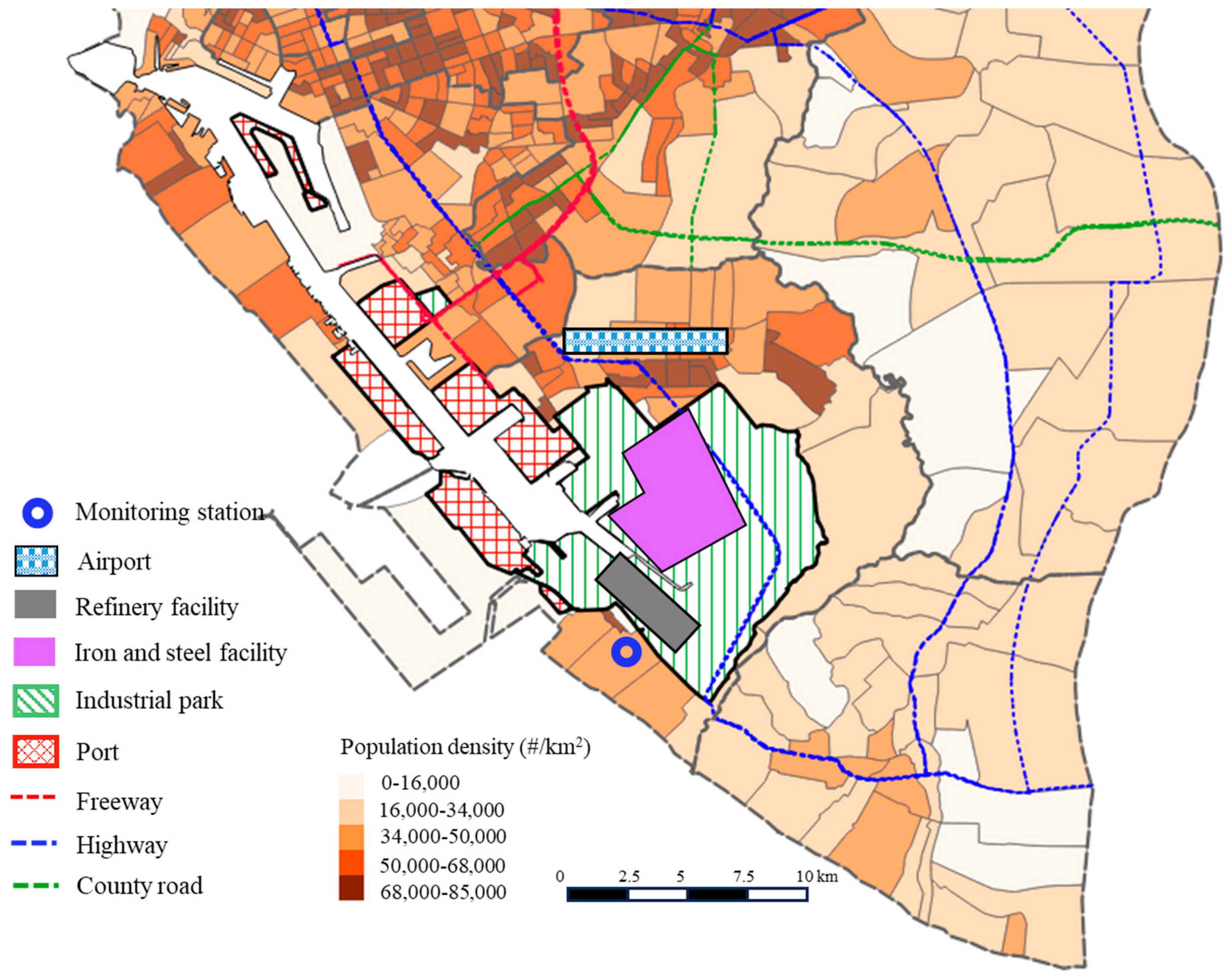
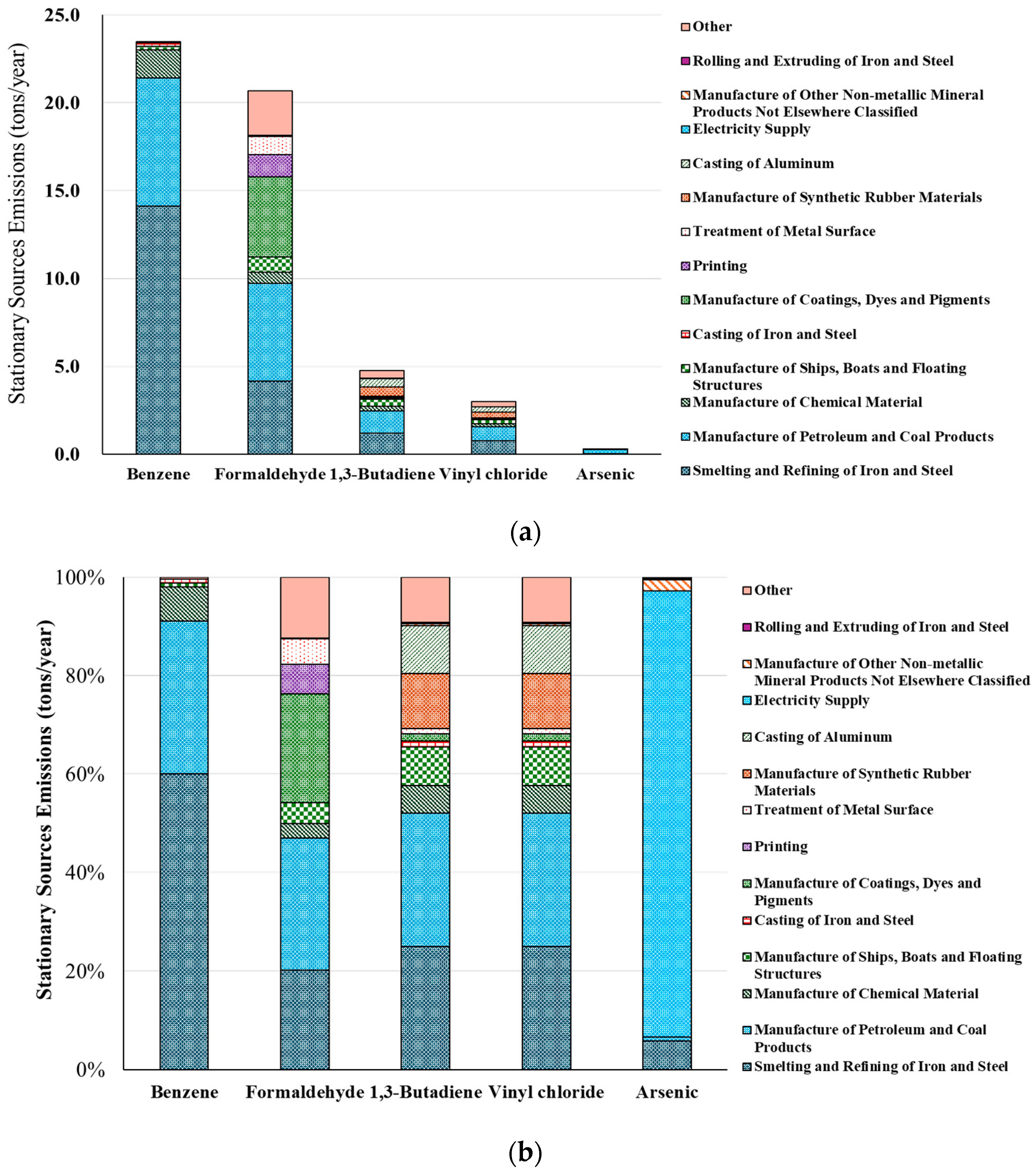

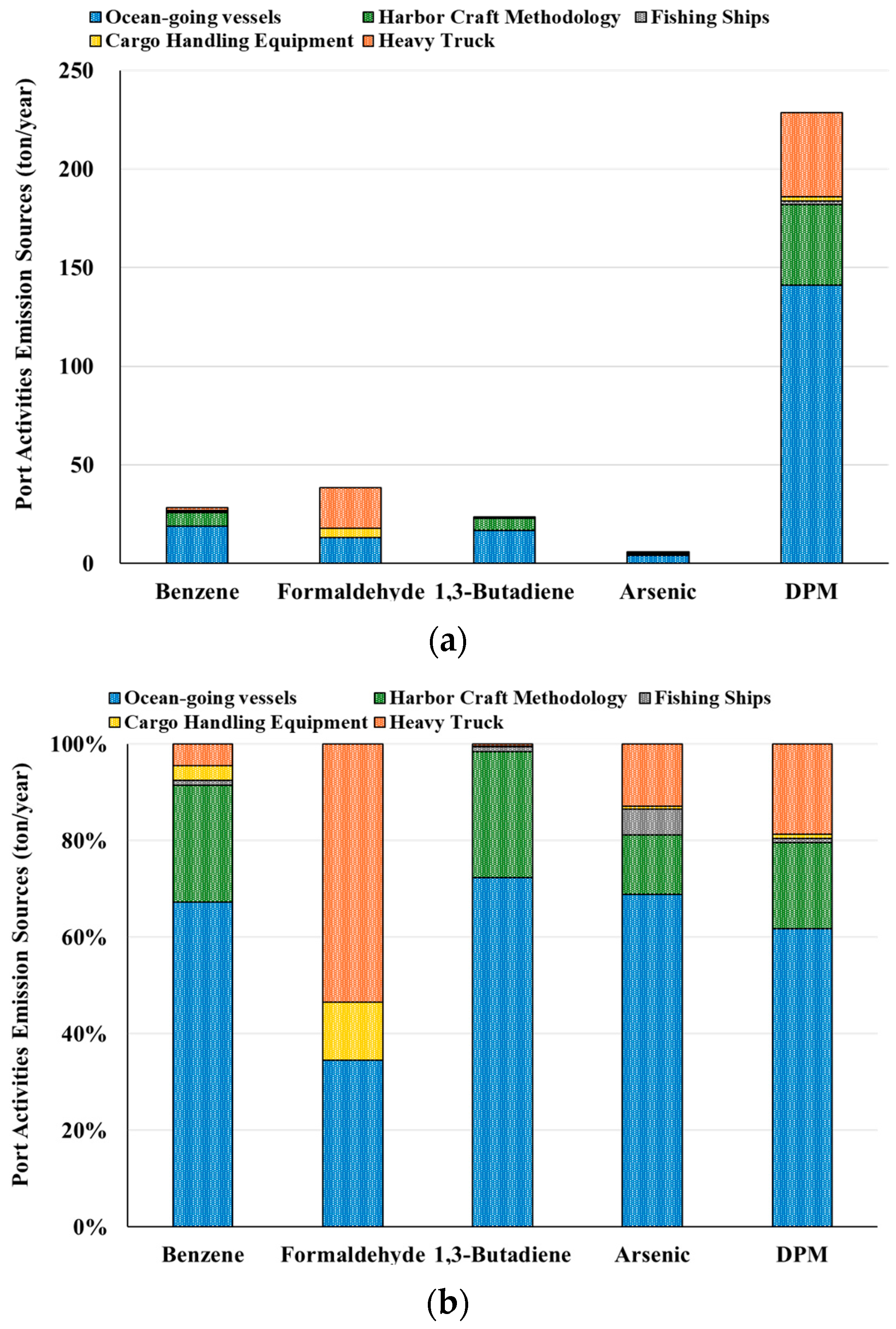
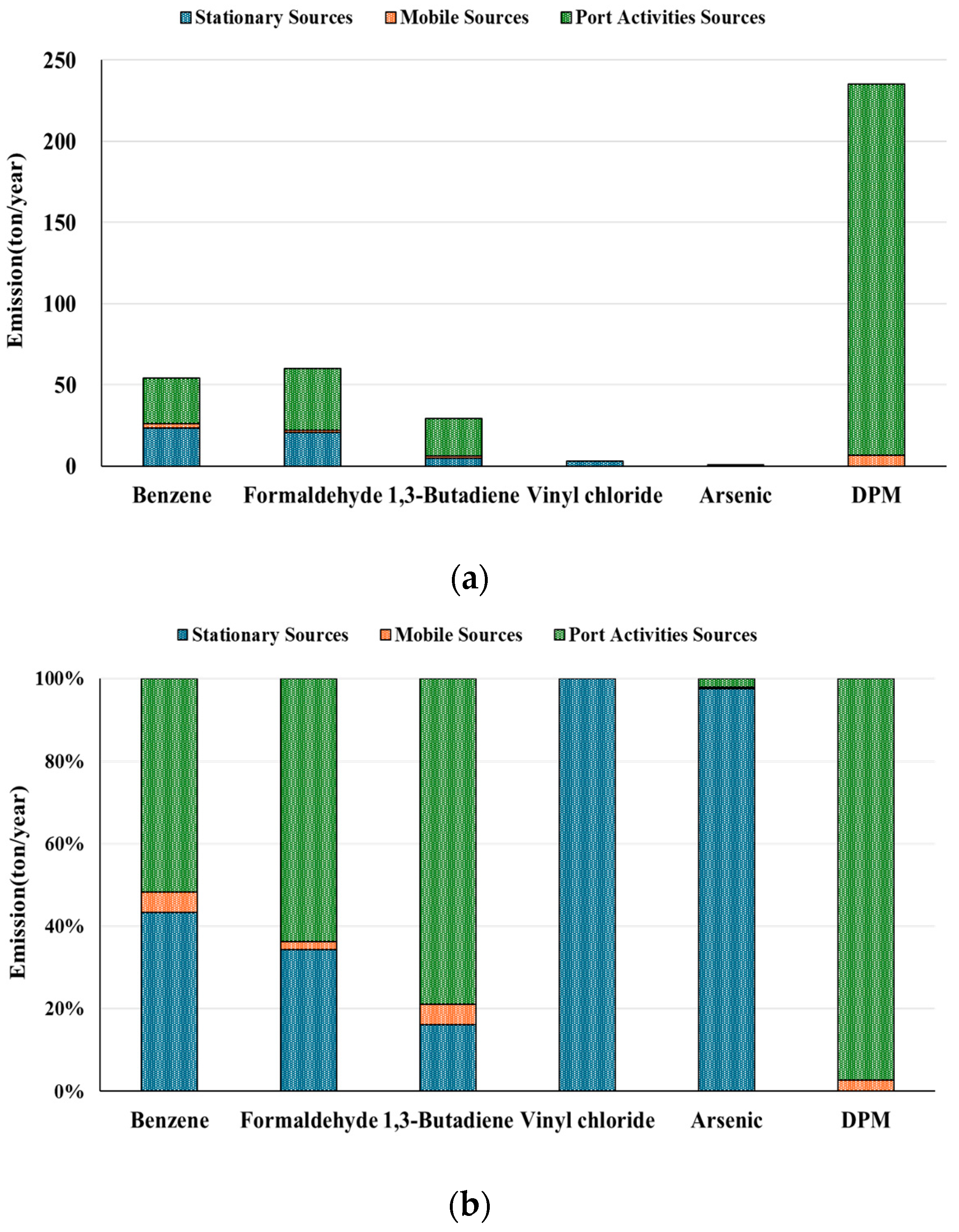
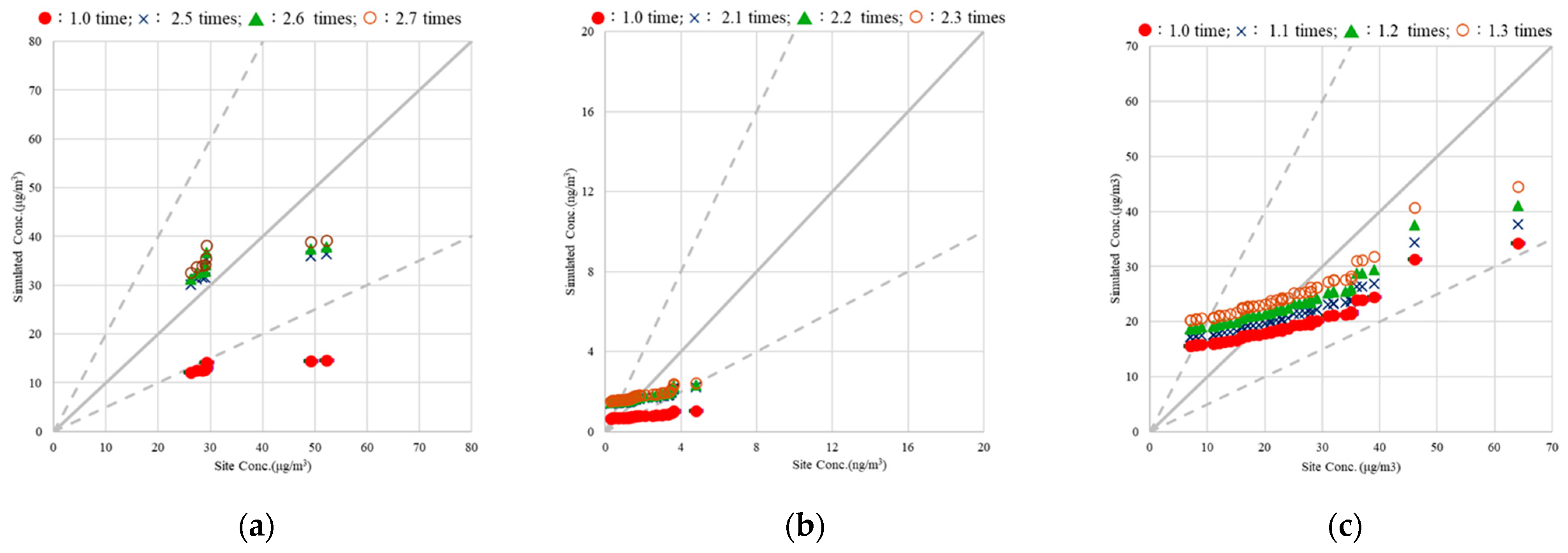


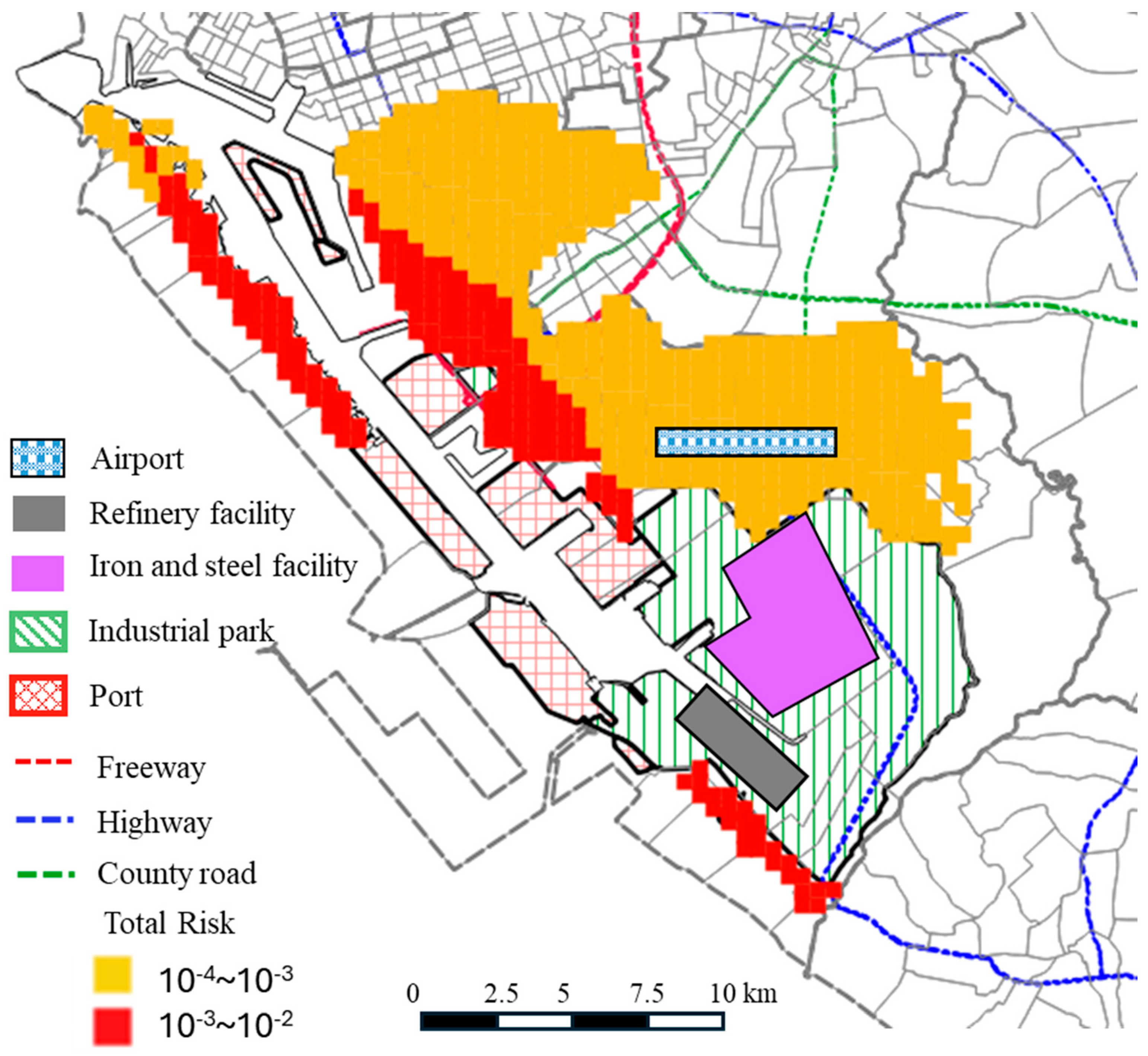
| # | CAS No. | Name | Classification 1 | ICPF 2 (mg/kg/day)−1 |
|---|---|---|---|---|
| 1 | 7440-38-2 | arsenic | 1 | 1.2 × 101 |
| 2 | -- | DPM | 1 | 1.1 |
| 3 | 71-43-2 | benzene | 1 | 1.0 × 10−1 |
| 4 | 50-00-0 | formaldehyde | 1 | 2.1 × 10−2 |
| 5 | 106-99-0 | 1,3-butadiene | 1 | 0.6 |
| 6 | 75-01-4 | vinyl chloride | 1 | 0.3 |
| Simulation Settings | Parameter | |
|---|---|---|
| Area | Industrial complex, port, and adjacent extended areas | |
| Topography | Complex | |
| Scope | 15 km × 15 km | |
| Coordinates | Starting point: (173,400, 2,488,600); Endpoint; (188,400, 2,503,600) | |
| Species | Benzene, formaldehyde, 1,3-butadiene, vinyl chloride, arsenic, DPM | |
| Source type | Stationary source (pipeline): point source; fixed source (escape): area source; mobile source: Ti source; port activities: area source | |
| Emission-source height | Stationary source: pipeline (input based on height of each chimney), escape (0.5 m); mobile source: 10 m for national roads, 0.3 m for provincial, county, and city roads; port activities: 25 m for ships, 39 m for handling equipment, 0.3 m for vehicles | |
| Grid resolution | 200 m × 200 m | |
| Meteorological data | Surface | Kaohsiung station |
| Profile | Pingtung station | |
| Simulation year | 2022 | |
| Notes | Used metropolitan area parameters and did not consider smoke downwash Used AERMOD main program, version 21112 | |
| Type | Benzene | Formaldehyde | 1,3-Butadiene | Vinyl Chloride | Arsenic | Total |
|---|---|---|---|---|---|---|
| Smelting and refining iron and steel | 15 | 1 | 7 | 2 | 2 | 27 |
| Manufacture of petroleum and coal products | 8 | 1 | 8 | 2 | 0 | 19 |
| Manufacture of chemical material | 2 | 0 | 2 | 0 | 0 | 4 |
| Manufacture of ships, boats, and floating structures | 0 | 0 | 2 | 1 | -- | 3 |
| Casting iron and steel | 0 | 0 | 0 | 0 | 0 | 1 |
| Manufacture of coatings, dyes, and pigments | 0 | 1 | 0 | 0 | -- | 2 |
| Printing | -- | 0 | -- | -- | -- | 0 |
| Treatment of metal surfaces | -- | 0 | 0 | 0 | -- | 1 |
| Manufacture of synthetic rubber materials | -- | 0 | 3 | 1 | -- | 4 |
| Casting aluminum | -- | 0 | 3 | 1 | -- | 4 |
| Electricity supply | -- | 0 | -- | -- | 30 | 30 |
| Manufacture of other non-metallic mineral products not elsewhere classified | -- | 0 | 0 | 0 | 1 | 1 |
| Rolling and extruding iron and steel | -- | 0 | 0 | 0 | 0 | 0 |
| Other | 0 | 1 | 3 | 1 | 0 | 4 |
| Total stationary sources | 24 | 5 | 30 | 8 | 33 | 100 |
| Type | Benzene | Formaldehyde | 1,3-Butadiene | Arsenic | DPM | Total |
|---|---|---|---|---|---|---|
| Gasoline vehicles | 2 | 0 | 3 | 0 | -- | 5 |
| Diesel vehicles | 0 | 0 | 0 | 0 | 86 | 87 |
| Motorcycles | 1 | 0 | 7 | 0 | -- | 8 |
| Other | 0 | 0 | 0 | 0 | -- | 0 |
| Total mobile sources | 3 | 0 | 10 | 0 | 86 | 100 |
| Type | Benzene | Formaldehyde | 1,3-Butadiene | Arsenic | DPM | Total |
|---|---|---|---|---|---|---|
| Ocean-going vessels | 1 | 0 | 4 | 0.0 | 58 | 62 |
| Harbor craft methodology | 0 | -- | 1 | 0.0 | 17 | 18 |
| Fishing ships | 0 | -- | 0 | 0.0 | 1 | 1 |
| Cargo handling equipment | 0 | 0 | 0 | 0.0 | 1 | 1 |
| Heavy trucks | 0 | 0 | 0 | 0.0 | 18 | 18 |
| Total | 1 | 0 | 5 | 0.0 | 93 | 100 |
| Sources | Benzene | Formaldehyde | 1,3-Butadiene | Vinyl Chloride | Arsenic | DPM | Total |
|---|---|---|---|---|---|---|---|
| Stationary | 1 | 0 | 1 | 0 | 1 | -- | 3 |
| Mobile | 0 | 0 | 0 | -- | 0 | 3 | 3 |
| Port Activities | 1 | 0 | 5 | -- | 0 | 88 | 94 |
| Total | 2 | 0 | 6 | 0 | 1 | 91 | 100 |
Disclaimer/Publisher’s Note: The statements, opinions and data contained in all publications are solely those of the individual author(s) and contributor(s) and not of MDPI and/or the editor(s). MDPI and/or the editor(s) disclaim responsibility for any injury to people or property resulting from any ideas, methods, instructions or products referred to in the content. |
© 2024 by the authors. Licensee MDPI, Basel, Switzerland. This article is an open access article distributed under the terms and conditions of the Creative Commons Attribution (CC BY) license (https://creativecommons.org/licenses/by/4.0/).
Share and Cite
Tsai, J.-H.; Yeh, P.-C.; Huang, J.-J.; Chiang, H.-L. Characteristics of Air Toxics from Multiple Sources in the Kaohsiung Coastal Industrial Complex and Port Area. Atmosphere 2024, 15, 1547. https://doi.org/10.3390/atmos15121547
Tsai J-H, Yeh P-C, Huang J-J, Chiang H-L. Characteristics of Air Toxics from Multiple Sources in the Kaohsiung Coastal Industrial Complex and Port Area. Atmosphere. 2024; 15(12):1547. https://doi.org/10.3390/atmos15121547
Chicago/Turabian StyleTsai, Jiun-Horng, Pei-Chi Yeh, Jing-Ju Huang, and Hung-Lung Chiang. 2024. "Characteristics of Air Toxics from Multiple Sources in the Kaohsiung Coastal Industrial Complex and Port Area" Atmosphere 15, no. 12: 1547. https://doi.org/10.3390/atmos15121547
APA StyleTsai, J.-H., Yeh, P.-C., Huang, J.-J., & Chiang, H.-L. (2024). Characteristics of Air Toxics from Multiple Sources in the Kaohsiung Coastal Industrial Complex and Port Area. Atmosphere, 15(12), 1547. https://doi.org/10.3390/atmos15121547






